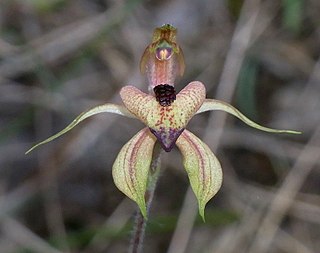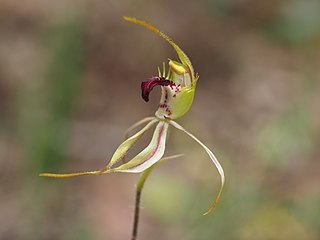Caladenia aestiva, commonly known as summer spider orchid, is a plant in the orchid family Orchidaceae and is endemic to south-eastern Australia. It is a ground orchid which grows singly or in small groups in the Australian Capital Territory and Victoria. It has one or two greenish-yellow to pale yellow flowers, often while the single, hairy leaf withers.

Caladenia cardiochila, commonly known as thick-lipped spider-orchid, fleshy-lipped caladenia and heartlip spider-orchid, is a plant in the orchid family Orchidaceae and is endemic to Victoria and South Australia. It is a ground orchid with a single hairy leaf and one or two yellowish-green, red-striped flowers on a thin, wiry stem.

Caladenia amnicola, commonly known as the Bundarra spider orchid is a plant in the orchid family Orchidaceae and is endemic to a small area in New South Wales. It has a single leaf and usually only one greenish-yellow flower with red markings and is only known from a single population.
Caladenia callitrophila, commonly known as the Berrigan spider orchid is a plant in the orchid family Orchidaceae and is endemic to a small area in New South Wales. It has a single leaf and one or two pale greenish-yellow flowers with red markings and only occurs in three small populations.

Caladenia excelsa, commonly known as the giant spider orchid, is a species of orchid endemic to a small area in the south-west of Western Australia. It is a rare species with a single, hairy leaf and up to three cream-coloured to greenish-cream flowers with long, drooping sepals and petals. It is one of the tallest spider orchids in Western Australia and, with Caladenia splendens, has the largest flowers of any Western Australian orchid.

Caladenia fitzgeraldii, commonly known as Fitzgerald's spider orchid, is a plant in the orchid family Orchidaceae and is endemic to New South Wales and the Australian Capital Territory. It is a ground orchid with a single hairy leaf and usually only one greenish-yellow and red flower.

Caladenia footeana, commonly known as the crimson spider orchid is a species of orchid endemic to the south-west of Western Australia. It has a single, hairy leaf and one or two, relatively small pinkish-red flowers with a white, red-striped labellum. Its relatively small size makes it hard to find in its surroundings.
Caladenia graminifolia, commonly known as the grass-leafed spider orchid is a species of orchid endemic to the south-west of Western Australia. It has a single glabrous leaf and one or two short-lived, greenish-yellow and red flowers which have a narrow labellum with long teeth on its sides.
Caladenia hoffmanii, commonly known as Hoffman's spider orchid is a species of orchid endemic to the south-west of Western Australia. It has a single, hairy leaf and one or two, greenish-yellow, red and white flowers which have a greenish-yellow labellum with a red tip. It is distinguished from the Pingaring spider orchid by small differences in the labellum and more northerly distribution.

Caladenia huegelii, commonly known as the grand spider orchid is a species of orchid endemic to the south-west of Western Australia. It has a single, hairy leaf and up to three relatively large red, green and cream-coloured flowers which have "split-hairs" on the sides of the labellum.

Caladenia montana, commonly known as the mountain spider orchid is a plant in the orchid family Orchidaceae and is endemic to New South Wales, Victoria and the Australian Capital Territory. It is a ground orchid with a single leaf and a single greenish-cream to cream flower, sometimes with reddish markings. It only grows in high montane forests.

Caladenia procera, commonly known as the Carbunup king spider orchid, is a species of orchid endemic to the south-west of Western Australia. It has a single erect, hairy leaf and up to four greenish-yellow and red flowers. It is one of the tallest and has amongst the largest flowers of the spider orchids.
Caladenia richardsiorum, commonly known as the little dip spider orchid, Richards' spider orchid or robe spider orchid, is a plant in the orchid family Orchidaceae and is endemic to South Australia. It is a ground orchid with a single erect, hairy leaf and usually only one yellowish-green flower. It is similar to the endangered Mellblom's spider orchid but has a much larger leaf and the petals lack glandular tips.
Caladenia rigida, commonly known as the stiff spider orchid, or white spider-orchid is a plant in the orchid family Orchidaceae and is endemic to South Australia. It is a ground orchid with a single hairy leaf and one or two white flowers with dark glandular tips on the sepals and fine reddish-brown lines along the sepals and petals.

Caladenia septuosa, commonly known as the Koppio spider orchid, is a plant in the orchid family Orchidaceae and is endemic to South Australia. It is a ground orchid with a single erect, sparsely hairy leaf and usually only one greenish-cream flower with red stripes along the sepals and petals.
Caladenia viridescens, commonly known as the Dunsborough spider orchid, is a species of orchid endemic to the south-west of Western Australia. It has a single erect, hairy leaf and up to three pale greenish-yellow flowers with faint red or pink markings.

Caladenia williamsiae, commonly known as Judy's spider orchid, or Williams' spider orchid is a species of orchid endemic to the south-west of Western Australia. It is a rare species with a single relatively large, erect, hairy leaf and one or two delicate, greenish-yellow and red flowers. It is only known from a single population near Brookton.
Caladenia woolcockiorum, commonly known as Woolcock's spider orchid, is a species of orchid endemic to South Australia. It has a single, long, erect, hairy leaf and one or two cream-coloured to greenish-yellow flowers recognised by their long, drooping lateral sepals and petals with their ends having dark glandular tips and by the red-tipped labellum.
Caladenia branwhitei, commonly known as the Bethungra spider orchid, is a plant in the orchid family Orchidaceae and is endemic to southern New South Wales. It has a single dull green leaf and one or two, usually dark red to maroon-coloured flowers. It is only known from three areas near Bethungra where it grows in ironbark forest.
Caladenia xanthochila, commonly known as the yellow-lip spider orchid is a plant in the orchid family Orchidaceae and is endemic to southern Australia. It is a rare ground orchid with a single leaf and usually only one pale greenish-yellow flower. Only a few plants are known from Victoria and South Australia.











